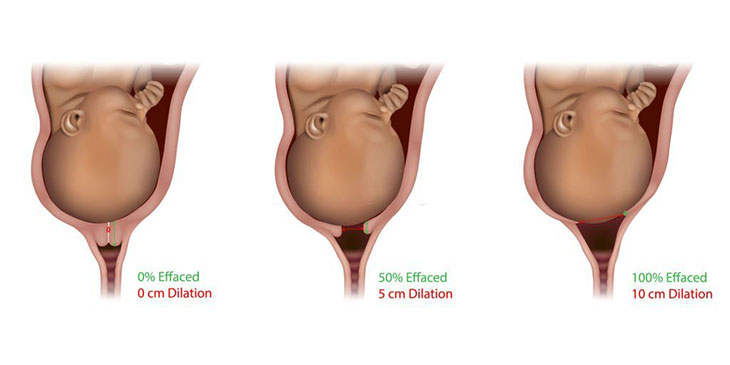If you’re past your due date and feeling impatient, you might wonder how to induce labor naturally?
While no method will be guaranteed to work, some people swear by certain foods, exercises, or alternative therapies.
In my article, we’ll explore some of the most popular and safe ways to try to kickstart your labor at home and by medical treatments.
How To Induce Labor At Home – 7 Practices

We will first consider how to force labor at home, including seven common natural methods. Don’t miss the content below to get the best natural solutions for your health.
Many healthcare professionals used to suggest them to many Moms; therefore, you can feel comfortable adopting these practices.
Walking & Exercise
It would help if you tried exercises to induce labor that gets your blood pumping, like a brisk walk. Not only will this help you relax and stay fit, but it might also trigger labor.
According to a trustworthy study, If you walk at a moderate speed (2.5 miles/hour), about 90 minutes/week can help you bring on labor earlier.
Remember to begin walking from week 38 to promote this process effectively and safely.
Keeping walking and following other exercises (cat-cow pose, butterfly stretch, and squats) also lowers the chances of needing medical help during delivery.
Sex
You might think sex is the last thing on your mind when you’re 40 weeks pregnant (or more!), but you might want to give it a go.
Sex can release hormones that help soften and open up your cervix, preparing it for delivery.
Sex may not work for everyone, and it may be unsafe if you have certain conditions, such as placenta previa, vaginal bleeding, or ruptured membranes.
You should always consult your doctor before trying any natural methods of how to activate labor.
Remember that you shouldn’t also have sexual activity after having your water broken or bad signs of labor.
If you have immediate treatments, this can put you at risk of infection and even danger to your health and baby.
Use Evening Primrose & Castor Oil
Evening primrose oil is a popular herbal remedy many pregnant women use to prepare for labor.
This plant contains substances that can mimic the effects of hormones that soften and open the cervix.
Taking evening primrose oil capsules in week 40 may help your cervix become more favorable for labor.
Castor oil is an old-fashioned remedy that some women use to induce labor.
When you drink a small amount, you can make your intestines cramp and squeeze, making your uterus contract and kickstart labor.
However, you should use castor oil constantly when you’re pregnant.
If your body is not ready for delivery, castor oil will only give you a nasty bout of diarrhea (something you don’t want to deal with before giving birth).
Stimulate Mom’s Nipple
When your nipples are touched, they send signals to your brain to release oxytocin. This is the same hormone that makes you feel close to your baby and helps you produce milk.
Oxytocin also has another benefit: it makes your uterus contract and gets smaller. This can help you recover faster after giving birth.
So whether you decide to feed your baby from your breast or chest, you can enjoy some nipple stimulation to induce labor after delivery.
You can do it yourself, ask your husband to help, or use a breast pump. Whatever feels good for you!
Eat Spicy Food
Are you craving some hot wings to kickstart your labor? Well, you might be disappointed. Spicy food doesn’t do anything to your uterus except make it angry.
Some doctors even warn against eating spicy food when you’re overdue because it could upset your stomach.
And trust us; you don’t want to deal with that on top of contractions. There’s no scientific proof that spicy food can help you go into labor.
But hey, if you love spicy food and are feeling adventurous, treat yourself to some fiery nachos. Just be prepared for some serious heartburn afterward.
This can keep your baby safe and maintain a healthy pregnancy.
Have Acupuncture Treatment
Acupuncture, the practice of inserting thin needles into specific points on your body, can work wonders for your labor.
Not only can it stimulate your uterus and encourage your baby to come out, but it can also help you relax and cope with stress.
Many experts and happy moms swear by acupuncture as a natural and effective labor inducement. It’s like a spa treatment for your womb!
Remember that acupuncture is not magic, and you should do it during the week from 39 to 40 to increase the rate of transitional labor.
So don’t expect miracles if you’re still early in your pregnancy.
But acupuncture can give you the extra push you need if you’re overdue or close to your due date. Make sure you talk to your pregnancy care providers before making an appointment.
Apply Acupressure On Feet Or Hands
Do you know how acupuncture can help start labor by poking needles in some places on your body? Well, you can do something like that without your hands, too.
Just use your fingers to squeeze the skin between your thumb and index finger, or rub the inside of your leg a few inches above your ankle.
It is one of the best tricks to induce labor that you should follow.
The four final weeks of the labor process are the ideal time to apply acupressure on your feet. You also consult your doctors before doing it to have the best experience.
Gentle Massage
Imagine relaxing on a massage table while your body naturally prepares for labor. That’s what a massage can do for you.
It can boost your oxytocin, the hormone that triggers labor contractions.
Some massage therapists have the skill and experience to help you start labor when you’re overdue.
They know how to target the right pressure points to stimulate your uterus. If you’re ready to try prenatal massage, ensure your doctor gives you the green light.
It would be best if you started having massages from the 34 weeks of pregnancy and can do it at home.
How To Induce Early Labor At The Hospital – 4 Ways

Applying medical treatments can be one of the good solutions to promote vaginal delivery in the final week of pregnancy.
However, you must follow these induction methods from professional and experienced doctors to prevent your health at risk.
Stripping Membranes
If you are near or past your due date and eager to meet your baby, you may wonder if there is a natural way to induce labor.
One option that your doctor may suggest is stripping the membranes.
This procedure involves separating the amniotic sac from the uterus with a finger. It can help release prostaglandins, chemicals that soften the cervix and trigger contractions.
Stripping the membranes can be done during a routine pelvic exam and may increase your chances of going into labor within 48 hours.
However, it is not without life-threatening complications, so you should discuss the pros and cons with your doctor before trying it.
Breaking Water (Amniotomy)
If your labor is not starting or progressing as expected, your doctor may recommend an amniotomy to help you along.
Amniotomy is a procedure that involves making a small opening in your amniotic sac with a special tool.
The amniotic sac is the bag of fluid that protects your baby. This procedure is also called breaking your water or artificial rupture of membranes (AROM).
When water breaks, it can trigger hormones and chemicals that boost your contractions and make them more regular.
It can also increase the pressure on your cervix and help it dilate more.
Amniotomy can induce (start) or augment (speed up) labor. It is usually done after 39 weeks of pregnancy and only if your cervix is open.
Amniotomy can shorten your labor and lower the chance of other interventions.
Still, it also has some risks and discomforts that you should talk to your doctor or midwife about before deciding.
Providing Hormone Prostaglandin
When you are ready to give birth, your cervix must change from thick and closed to thin and open.
This process is called cervical ripening. One way to help your cervix ripen is by using a prostaglandin hormone.
Prostaglandin is a natural chemical that your body makes during labor. It helps your cervix soften and dilate and triggers your uterus to squeeze and push your baby out.
Your doctor can give you prostaglandin as a gel, a suppository, or a slow-release insert that goes into your vagina next to your cervix.
Prostaglandin can also have some risks of labor induction, such as nausea, fever, or diarrhea. You should discuss it with your doctor about this problem.
This will help the process of inserting the hormone prostaglandin become one of how to encourage labor safer for you.
Providing Hormone Oxytocin
When you’re in labor, your body produces a miracle hormone called oxytocin. It makes your uterus work like a powerful engine, pushing your baby out easily and efficiently.
Sometimes, you may need a boost of oxytocin to start your labor or keep it going. We offer oxytocin as a simple drip that goes into your vein.
Oxytocin will make your contractions more frequent and effective, saving time and energy.
It can also help you avoid excessive bleeding after birth, which can be dangerous for you and your baby.
This ingredient can work differently on labor among women. It can lower your blood pressure, overstimulate your uterus, or affect your baby’s heart rate.
Please keep careful with any medical treatment during the months of pregnancy.
Why Would You Need To Apply How To Stimulate Labor?
When you’re pregnant, you want your labor to start naturally and smoothly. But sometimes, nature needs a little nudge.
That’s why your doctor may suggest inducing your labor. Inducing labor means making your uterus contract before it does on its own. Your doctor may advise you to induce labor if:
- You are overdue, and your baby is still cozy inside. This can put your baby at risk of serious problems like infection, low fluid, or stillbirth.
- Your water breaks, but nothing else happens. This can open the door for germs or cord problems.
- You have a health issue that threatens your pregnancy, such as high blood pressure, diabetes, or preeclampsia. These issues can hurt you or your baby if you wait too long.
- Your baby has a problem that affects its growth, development, or oxygen supply. These problems can include poor growth, fetal distress, or placental abruption.
Sometimes, you may want to induce labor for your reasons, such as convenience, comfort, or anxiety.
These are called “elective” or “social” inductions. However, elective inductions are not a good idea before 39 weeks of pregnancy unless there is a medical reason to do so.
Should You Wait To Induce Labor Naturally?
Your cervix knows how to prepare for birth in the best and most comfortable way. But sometimes, things don’t go as planned.
If you or your baby have health problems or is overdue by two weeks, you may need to start labor yourself.
What’s the problem with being two weeks late? Well, your baby might not have enough water around them.
They might also grow too big and make it hard for you to push them out. You might need a C-section; your baby might not survive or breathe in their poop.
Should You Require An Elective Induction?

Sometimes, you might want to start labor intentionally, even if you and your baby are healthy.
For example, if you live far away from where you will give birth or usually have very fast deliveries, you should plan and avoid surprises.
In these cases, your doctor or midwife will ensure your baby is old enough (at least 39 weeks) before they help you start labor.
Some new studies show that starting labor at 39 or 40 weeks can benefit women with low-risk pregnancies.
It can lower the chances of bad things happening, like your baby dying before birth, your baby being too big and hard to deliver, or your blood pressure getting too high.
You and your doctor should talk about what’s best for you and your baby if you want to promote labor induction.
Risks Of Having Labor Induction On Mom
If you only focus on how to induce labor quickly without considering potential risks, you will put yourself and your baby from active work to dangerous health problems.
We have collected five common incidents you can encounter when using how to induce labor at 40 week, which helps you prepare the best solutions.
Failed Induction
Sometimes, induction doesn’t work. If your labor doesn’t start or progress after a day of trying, you might need a C-section to have cesarean delivery safely.
Uterine Rupture
This rare and deadly risk occurs when the uterus tears apart at an old wound from an earlier C-section or major uterine operation.
You must have an emergency C-section to survive and protect your baby. You may have to give up your uterus as well.
Low Fetal Heart Rate
The drugs that start labor — oxytocin or prostaglandin — can make your contractions too strong or too frequent. This can reduce the oxygen your baby gets and slow down their heartbeat.
Serious Infection
Some labor inductions, like popping the water bag, can expose you or your baby to infection. This can be very dangerous for both of you.
Remember to follow how to induce labor, proved by scientific evidence safely. This can help you a lot during pregnancy.
Bleeding Problems
Labor induction can make your uterus weak and unable to tighten after birth (uterine atony). This can cause heavy bleeding that might need blood transfusions.
If this problem occurs constantly, contact your doctor to have the right treatments.
FAQs
What Kinds Of Food Can Open The Cervix To Induce Labor?
Many pregnant women wonder if certain foods can help induce labor naturally.
Some believe that spicy foods, pineapple, dates, and eggplant, can stimulate contractions and open the cervix.
However, there is no scientific evidence to support these claims. The best way to induce labor is to consult your doctor and follow their advice.
When Is It Good And Safe To Induce Labor?
Inducing labor is a medical procedure that can help start or speed up the process of childbirth.
It may be recommended for various reasons, such as health risks for the mother or baby, overdue pregnancy, or convenience.
The best time to induce labor is when the baby is full-term (at least 39 weeks), and the cervix is favorable (soft, thin, and dilated).
How Should You Have Nipple Stimulation To Induce Labor With Hands?
Nipple stimulation is a natural way to induce labor. It releases oxytocin, the hormone that causes contractions.
To do it, gently massage your nipples with your fingers, or use a breast pump. Repeat for 15 minutes every hour until labor starts.
Conclusion
Following how to induce labor correctly and consulting your doctor is the best way to keep yourself and your baby healthy.
If you are sure about anything, please check more from good knowledge sources on the Internet, books, or magazines for moms and babies.
This can bring better results during pregnancy time.
